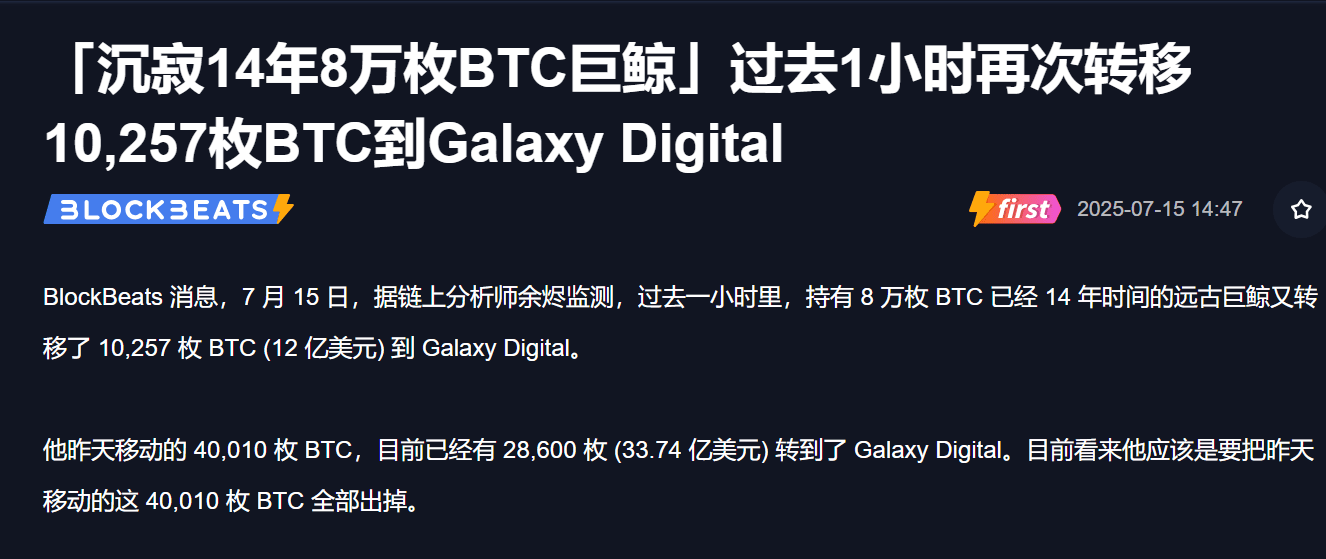Policy upheaval: Full deregulation of bank custody.
The three major financial regulatory agencies in the U.S. jointly released new regulations, completely reshaping the bank custody rules for crypto assets. The pre-reporting system has been abolished, allowing banks to directly hold Bitcoin and other crypto assets; full compensation liability has been introduced, clearly stating that banks must compensate customers 100% for losses in the event of lost private keys or hacking incidents. This policy shift paves the way for traditional financial institutions to deeply engage in the crypto field.

Market anomalies: Massive capital quietly migrating.
On-chain data shows that 1,598 BTC were swiftly transferred into institutional cold wallets after the new regulations were announced, with giants like BlackRock accelerating their layout through banking custody channels.
Abnormal capital flows emerge, with 250,000 USDC suddenly hitting Binance's SOL trading pair, while it is revealed that European companies are using the SOL chain to transfer $930 million in tariff funds, making compliant channels a new money laundering risk.
Bull-bear game: Market landscape undergoing severe reconstruction.
Bullish logic: Surge in banking custody demand may trigger a 'bloodsucking market' for BTC, with compliant targets receiving strong attention—Circle surged 9.27% in a single day, while mining firm Canaan Creative skyrocketed 34.72%, showing a clear influx of institutional funds.
Short-selling crisis: The new OCC regulations grant banks the authority to freeze suspicious assets, and DeFi protocols face compliance crackdowns; Ethereum L2 may be forced to embed regulatory backdoors, and the value of technologies like ZK-Rollup may be undermined, putting the market under liquidation pressure.
Core controversies: Three major uncertainties in future policies.
Balance sheet mystery: Can banks directly hold Bitcoin?
Crypto loan gateway: Will related services be opened up?
Key management black hole: OCC documents reveal that banks can outsource key management to third parties, with a Wall Street giant reportedly in talks with Binance to take over 1.5 million BTC cold wallets, raising concerns about 'controlling Bitcoin in the name of compliance.'

Retail response: Finding leverage points amidst the compliance wave.
Layout of compliant assets: Focus on stablecoin targets such as CRCL and USDC ecosystems, closely monitor the SOL/BTC exchange rate (critical threshold of 0.0092) and tariff fund flows.
Avoiding regulatory risks: Withdraw from mixers and privacy coins, and migrate DeFi staking to compliant platforms in Hong Kong and other non-U.S. locations.
CPI data hedging strategy:
CPI ≤ 2.4%: Increase BTC spot holdings to guard against potential bank selling pressure;
CPI ≥ 2.8%: Short ETH/BTC exchange rate, betting on the amplifying negative effects of L2 regulation.
Deep reflection: The cost behind prosperity.
Traditional financial giants enter the market with $12 trillion in capital, driving mainstreaming of the industry, while high custody fee rates (such as 3%) also raise concerns about 'Bitcoin becoming Wall Street's ATM.' This integration and game is both a necessary path for the crypto world to mature and a severe test of its decentralized original intention.#CPI数据来袭 #比特币巨鲸动向
CPI countdown: 2.4% → go long, 2.8% → go short, my hedging arsenal kicks off tonight.
Want to delve into the crypto space but can't find direction? Want to quickly master the information gap? Click on my profile to follow me! I share timely news and in-depth analysis, providing precise trading signals and keeping you updated on crypto dynamics!



